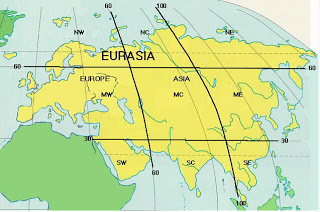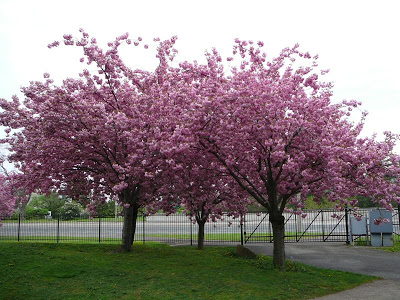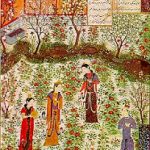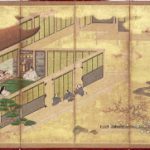In all my garden research thus far, I have often wondered why there is so much information on gardens in Europe, the Middle East, China and Japan and seemingly less so or else very hard to find in other countries such as South America. These other civilizations survived for millennia and yet it is only with their colonization that there is the mention of gardens. I realize that most likely all civilizations had gardens in some form or another, and if that is so, the information was never written or passed down or perhaps it was destroyed by its conquerors.
However, for me, the question is still pertinent. Why did the evolution of the garden form move east to west, from Asia to Europe? Why not north-south?

I think part of the answer may lie in a book written by Jared Diamond calledGuns, Germs, and Steel. The idea behind this book is that from the earliest civilizations Eurasia had advantages over other countries on Earth. Simply put, that area had a large variety of plant and animal species that were easy to domesticate. As well, climatic conditions and the geographic locations were more favorable; hurricanes, tornados, flooding and drought were minimal and the many rivers and mountains provided natural protective barriers.
Early civilizations were nomadic but as they developed towards an agrarian way of life they started to remain in one place to farm, raise animals and raise their families. They might settle in areas where berries, nuts, roots were naturally available and cultivate them in place. The Middle East in particular had the widest variety of plants and animals suitable for domestication. They grew two kinds of wheat, barley, flax for textiles, and kept sheep, cattle and goats for meat and their by-products such as dairy products, wool, leather and glue (from horns and bones). They had animals such as horses and donkeys and camels that were used for transportation of their goods and therefore for trade.
When you look at north- south options it becomes clear that there were disadvantages that inhibited the success that was had in Eurasia. For example, if we look at Africa, desert areas are inhospitable with poor plant life, and a scarcity of water. Available animals such as the zebra and onagers (both part of the horse family) are not easy to domesticate, and the existence of lions, cheetahs and other deadly animals certainly made life interesting. In addition, useful plants that survived at one end of the continent usually could not survive the conditions if moved to another area, whether due to soil, weather or available sunlight. Mr. Diamond also cites examples from the Americas and Australia which support this idea.

Seemingly, this advantage of living in the Eurasian zone led to advances in all areas compared with other civilizations. With better food options there is increased food production; a larger food base allows for larger societies; large societies support the division of labour, permit more ‘free’ time, and allow specialist areas to evolve such as gardens and gardeners. The East – West orientation of Eurasia allowed for an easy exchange of ideas. Trade routes over land were possible since the animals used were accustomed to the similar climates and change of seasons. The discovery and the exchange of plant materials fared the same regarding seasonal changes and climate, and a plant brought over from China or Turkey could grow just as successfully in its new home country.
In my own view, this East- West continuum eventually includes North America. Evidence is the ease in which plants from the east grow in our homes and gardens, and the same is true of North American plants growing in Europe and the Far East (I do not know if the Middle East grows plants from North America). We also share many siblings in common such as the maple, cherry and dogwood, and yet without similar climate growing them here would not be possible.
I have also found it odd that this question of East-West garden evolution does not seem to be raised by other garden writers. It is always referred to as a fact and left at that. Perhaps it is simply that I have not read books that do discuss this, and so I call out to you to tell me wrong and refer me to books where I can find more of the information that I seek.






Dear Patty, This is indeed an interesting question and one which I do not believe has been debated elsewhere. I shall be fascinated to read more as your research uncovers further information.
http://elephantseyegarden.blogspot.com/2009/08/where-proteas-live.html I have a map of the plant kingdoms of the world. Most of the Northern hemisphere rates one single plant kingdom. http://en.wikipedia.org/wiki/Boreal_Kingdom
And the tiny fynbos kingdom, one of six in the whole world, gives such a huge variety of plants. (Some invasive like the Oxalis.)
I really enjoying reading your blog because it is so unique.I always learn about something fascinating.Keep up the great work.Carolyn
Edith – Thank you for your continued interest.
Elephants Eye- I appreciate the links and found the information quite interesting.
Carolyn -Thank you for your kind words.
I've never thought about how original gardens evolved, so thanks for such an enlightening post. It's interesting how obsessed some folks are with creating gardnes out of plants that don't grow well here when we're surrounded by amazing easy care natives.
Patty, This is a fascinating post and I agree wholeheartedly with Carolyn! You are unique!! Very interesting. I do not know the answer. I always thought of the first gardens coming from the middle east but then that is because 'the bible says so' you pose a very interesting question about South America. I think I might join you in researching this topic. I am so tired I may be misunderstanding your question and points all together. Very stimulating and intriguing none the less.
TS- Thanks so much for your comment. Like you I lean towards natives.
Carol- Thanks for the kind words. I'd love to hear what you discover should you decide to investigate further.
Yes, well said Carolyn!Patty your blog is always so enlightening and poses questions that are very thought provoking and interesting…Your hard work and research is much appreciated!
Thank you for posting this.I never gave garden evolution a thought prior to this.I think it is interesting.Do let us know if you come across more in your research.
I am passing on the Stylish Blogger Award to you for your wonderful blog! Hooray!
Hi Patty, An interesting subject. I have a few random thoughts on the general subject. It seems to me that flower gardening (as opposed to growing food) requires a degree of wealth and leisure time. Certain area of the world seem to have had these benefits in greater abundance than others. It also seems to me that we tend to know about the agriculture as described in books. In South America, for example, there is less recorded agricultural history. That is not to say that there was no gardening, more that there is no record of said gardening.
I enjoyed reading this post a lot. I have read Guns, Germs and Steel, and found the book fascinating, but I haven't thought about its application to gardening. Thank you for providing a new perspective.
I also enjoyed your post on Josephine's garden. She is well-known to rosarians, of course, and there is a bourbon rose named after her garden.